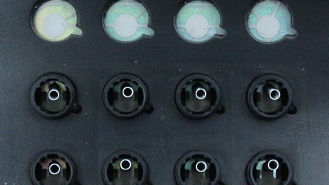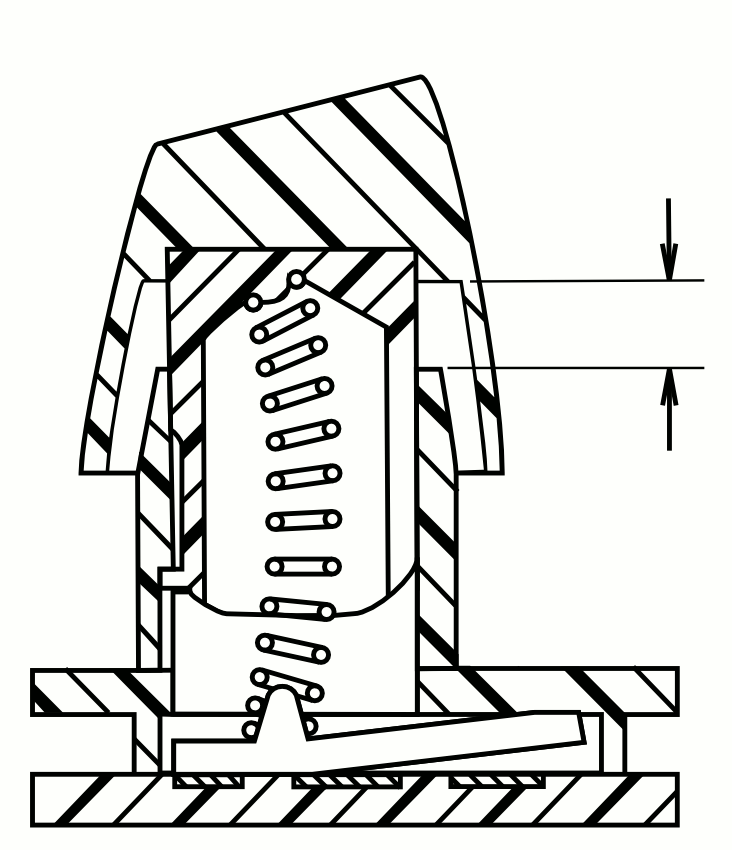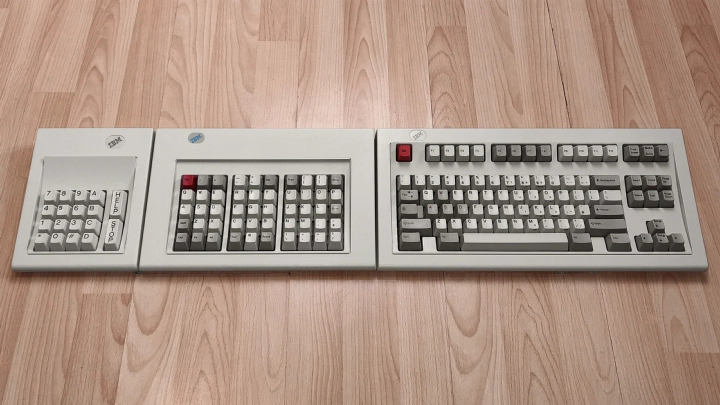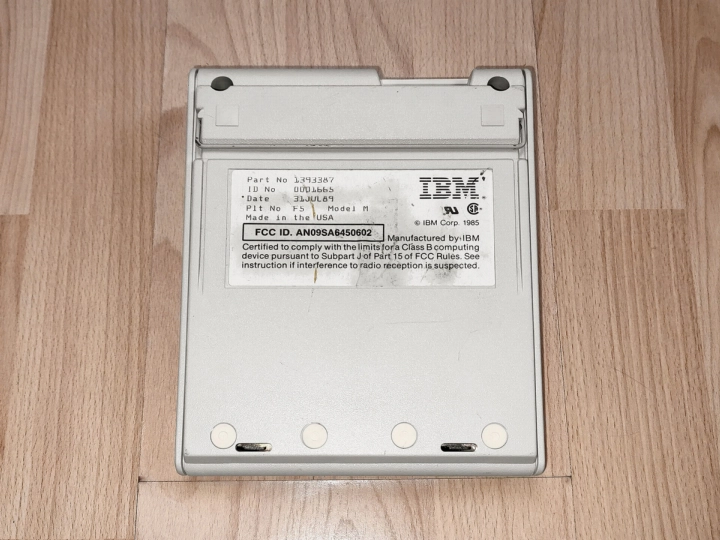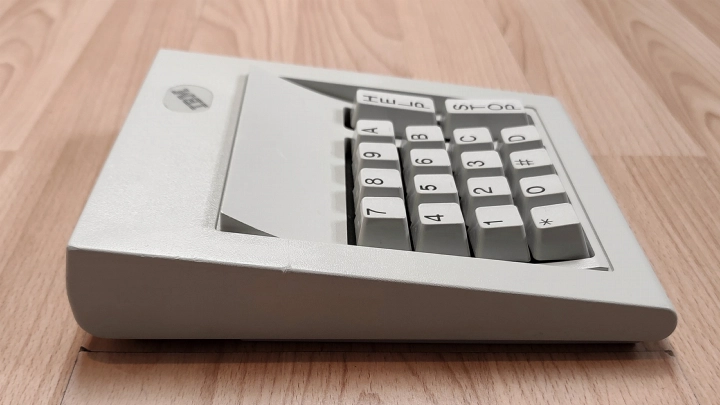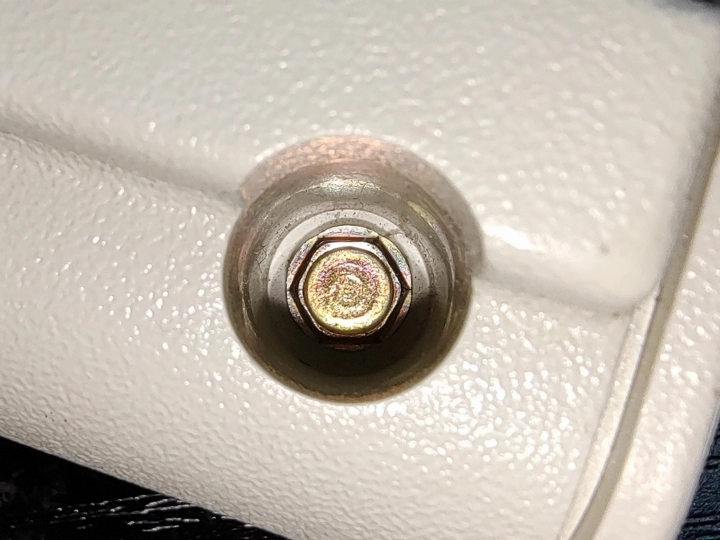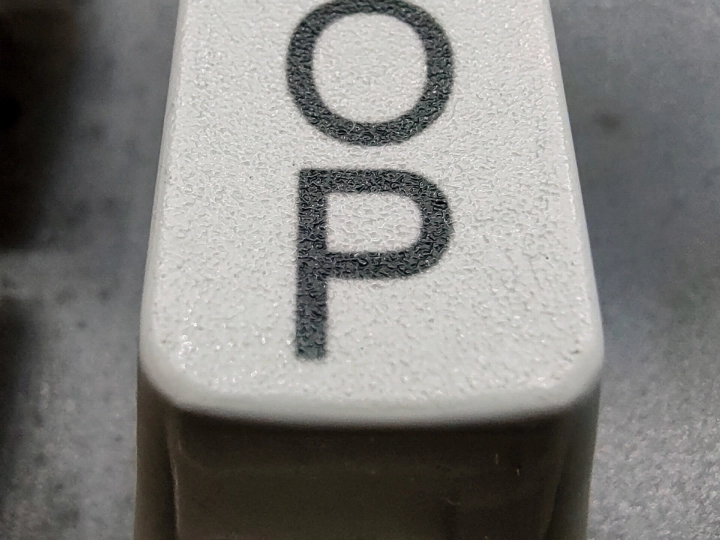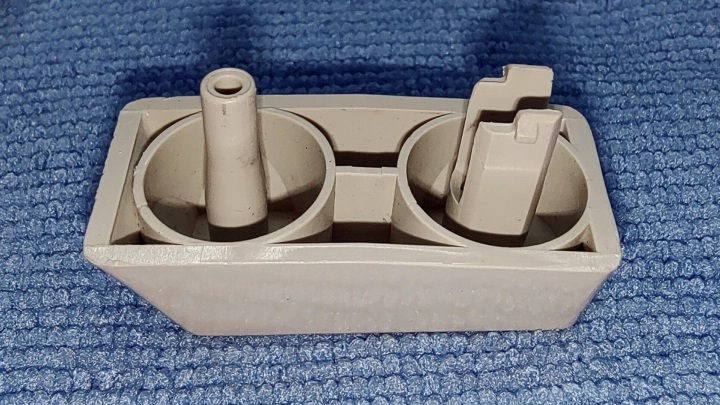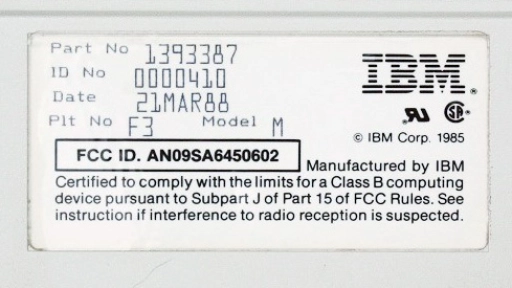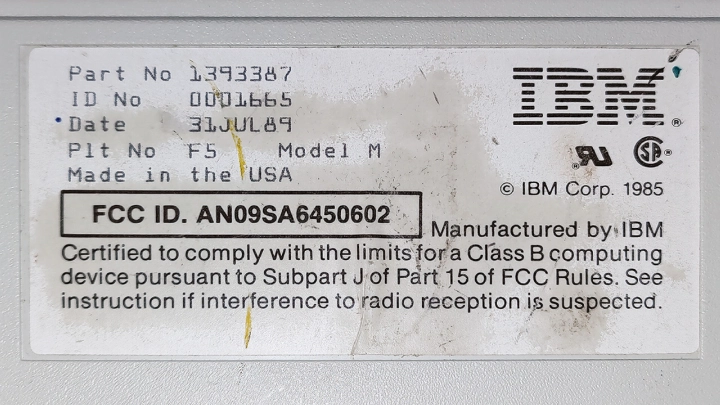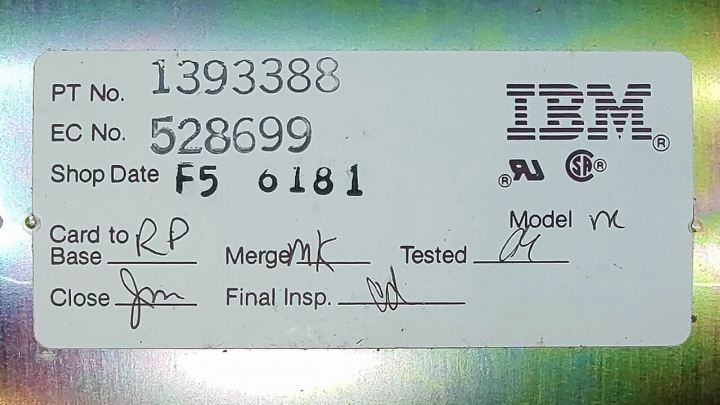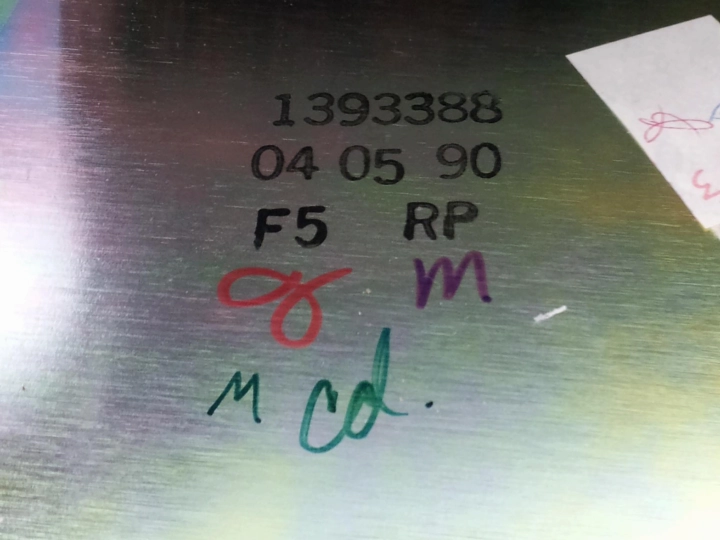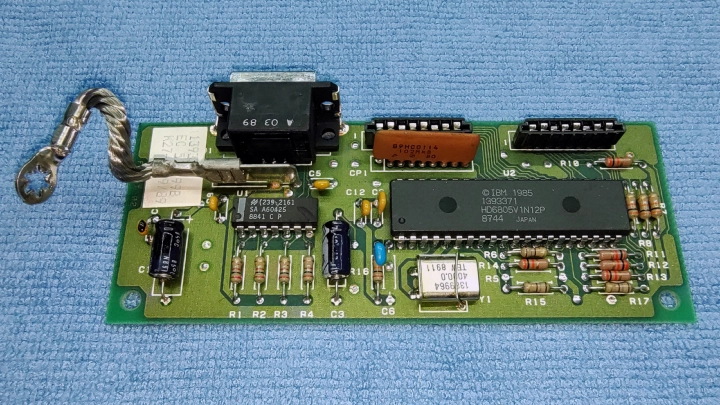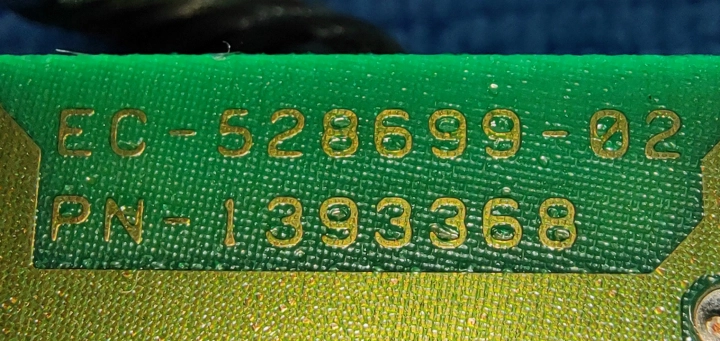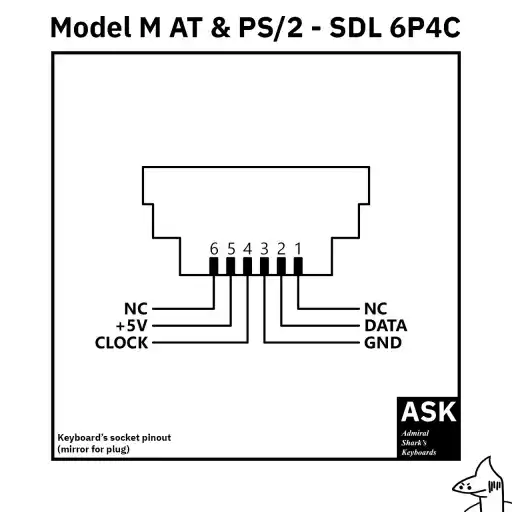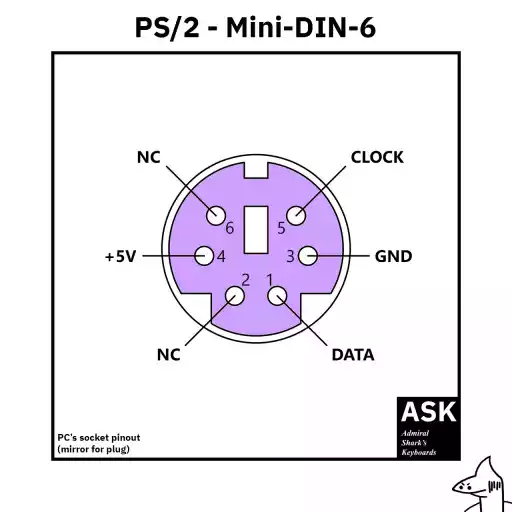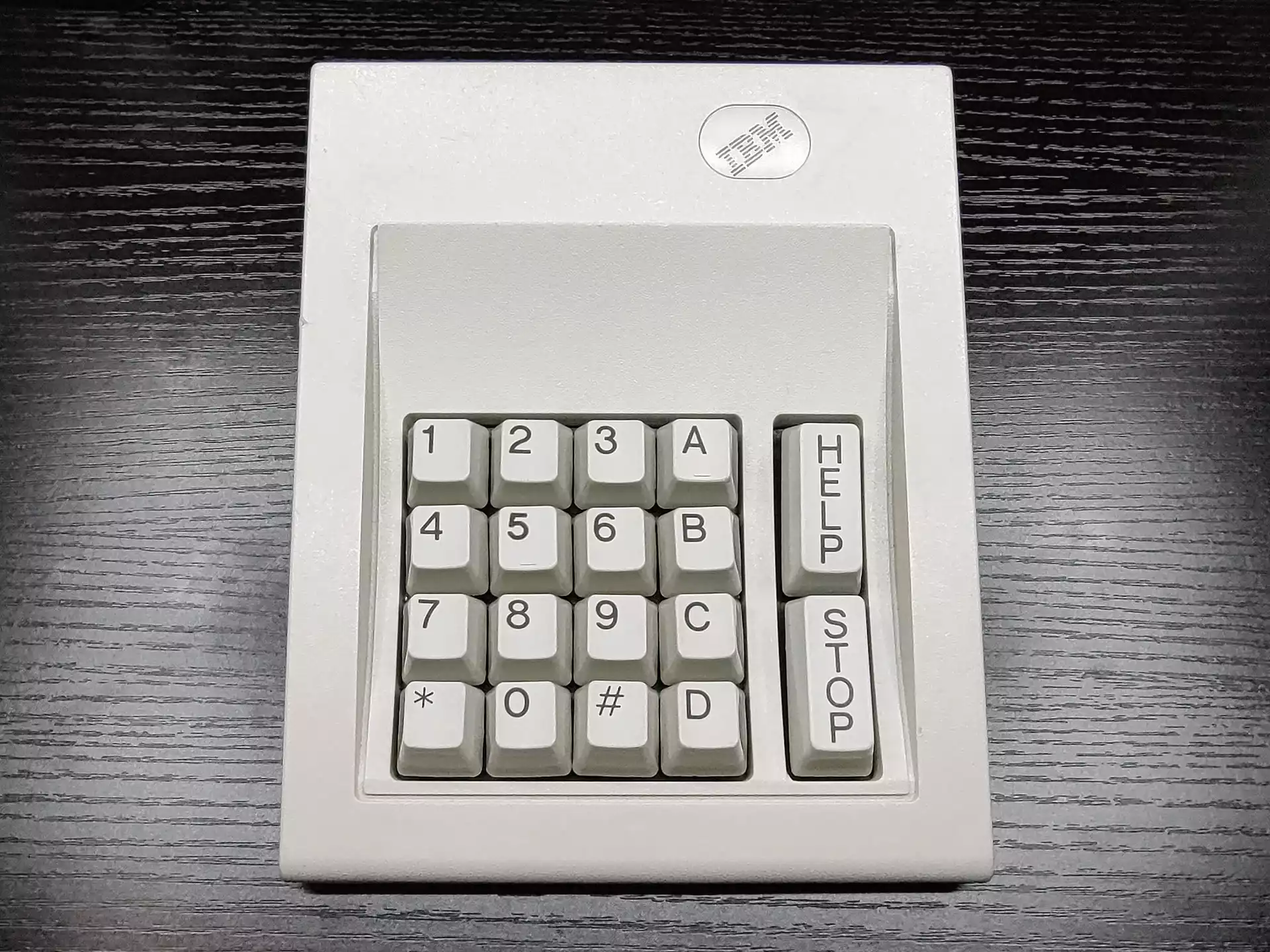- Updated
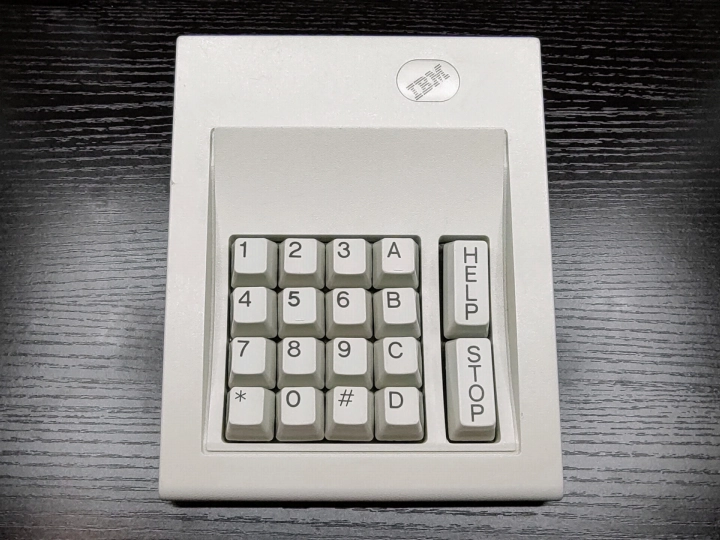
The IBM Screen Reader Keypad ("SRK") was an 18-key function keypad that served as the peripheral component of the IBM Screen Reader series, first announced in January 1988. The IBM Screen Reader was the inaugural product of the IBM Independence Series range[1] and on introduction a pioneering screen reader designed to help people with hard or lack of sight access a PC. Whilst this keypad may be (erroneously) solely attributed and named after the IBM Screen Reader/2 that was released as late as June 1992[2], the Screen Reader Keypad was actually introduced with Screen Reader 1.0 and was included with versions 1.1, Screen Reader/DOS series and finally Screen Reader/2 series without modification to the keypad design. The Screen Reader Keypad is a part of the large Model M keyboard family and is currently the second smallest known member that uses IBM's famed buckling spring clicky keyswitches (behind only the Model M15 Numeric Keypad Option). It's a very dense device and in fact shares numerous IBM Model F esque internal design traits, something due to the fact it's related to the earlier IBM 3290-1/5080 Numeric and Program Function Keypads. Whilst it has a PS/2-style plug, the Screen Reader Keypad does not work correctly through a PS/2 keyboard port. Only one part number is known - 1393387 (FRU 1393515, feature code 2549). The Screen Reader Keypad was withdrawn from marketing on 28th April 1995 and replaced by a new keypad with an integrated cable (P/N 06H5990)[3].
Contents
| Marketing names | IBM Screen Reader Keypad |
|---|---|
| OEM(s) | IBM U.S., Lexmark |
| Designation | M |
| Family | Model M |
| FCC ID(s) | ANO9SA6450602 |
| First appeared | January 1988[1] |
| Withdrawn | April 1995[3] |
| Keyswitches | IBM buckling spring (membrane variant) |
| Keycaps | Dye-sublimated PBT |
| Cover set dimensions | 15.2cm x 19cm x 3.8cm (6" x 7.5" x 1.5")[ASK] |
| Cover set colour(s) | Pearl white |
| Cover set screws | 7/32" (~5.5mm) hexagonal |
| Weight | 772g (~1.7lbs, 1989)[ASK] |
| Layout | 18-key |
| Connectivity | SDL 6P4C to 6-pin Mini-DIN cable (Connects to a PS/2 mouse port or a special interface card) |
| Predecessor | IBM 3290-1/5080 Numeric and Program Function Keypads (tooling progenitor) |
History
Work on what would become the IBM Screen Reader began in 1984 as a project for an "audio access system" by Jim Thatcher, a then mathematician working at IBM. His work culminated in IBM announcing in 1986 that IBM Screen Reader was coming for DOS[4]. On 26th January 1988, the IBM Screen Reader Keypad's FCC application was registered[5] and its host IBM Personal System/2 Screen Reader package (P/N 6450602) was announced, slated for availability on 18th March 1988. This version 1.0 of IBM PS/2 Screen Reader packed the 18-key Screen Reader Keypad (FRU 1393515, feature code 2549), Screen Reader Keypad Cable (P/N 72X8537, feature code 2550, 6-pin SDL to PS/2-like plug), complimentary software, and documentation[6] and was touted as enabling "the blind or visually impaired computer user to "hear" the display as the sighted computer user "sees" it"[6].
IBM PS/2 Screen Reader v1.0 was withdrawn from marketing effective 15th December 1989[7] and replaced with IBM Screen Reader 1.1 ("Personal System/2" was dropped from the name), which was announced on 24th October 1989 and planned availability was slated for the same day v1.0 was withdrawn. v1.1 is upward compatible with v1.0 and the keypad design was unchanged. However, the software was now available in a version for PS/2 (P/N 6450616) and a version for PC/XT and PC/AT compatible PCs (P/N 6450617). The PC version also comes with a Screen Reader Adapter[8] (P/N 57F1588, feature code 2551[9]), which was an 8-bit ISA expansion card that added a PS/2-like 6-pin mini-DIN port specifically for the Screen Reader Keypad.
On 23rd June 1992, the Screen Reader line was shaken up again as v1.1 was announced to be replaced with IBM Screen Reader/DOS Version 1.2 and a separate IBM Screen Reader/2 Version 1.0 would be released. IBM Screen Reader/DOS is the direct replacement for Screen Reader v1.1 as it's intended for [IBM] DOS only (version 3.3 or later) and follows the previous release's version nomenclature. It was made available on 30th June 1992 and continued recommending the same hardware components[9]. Like the original product, IBM Screen Reader/2 was developed under Jim Thatcher and was the first screen reader for a graphical user interface (GUI) on PCs[4]. Screen Reader/2 was intended for use with PS/1 or PS/2 compatible PCs running IBM OS/2 2.0, although it could be used with some PCs lacking a PS/2 mouse port via the existing Screen Reader Adapter. It was made available on 8th September 1992[2]. The key difference between Screen Reader/DOS and Screen Reader/2 and earlier releases was that the Screen Reader Keypad, Screen Reader Keypad Cable and Screen Reader Adapter were now technically separate purchases[10].
Screen Reader/2 1.0 would be followed up by versions 1.1 and 1.2 within a year. On 24th August 1993, Screen Reader/2 Version 1.21 was announced that required IBM OS/2 Warp 3.0 and introduced a new keypad (P/N 06H5990) that now has a fixed cable and could be connected to a Serial port, PS/2 mouse port or via the existing Screen Reader Adapter[11]. There's presently no surviving evidence of what this keypad looked like and whether it was even Model M based. v1.21 was withdrawn from marketing effective 31st March 1996[12]. Screen Reader/2 2.0 is believed to be the final release, made available on 1st December 1995 and now supporting OS/2, Windows and DOS in one package[13]. Before this launch, however, the original Screen Reader Keypad and its cable were withdrawn from marketing on 11th April 1995[3].
Pricing
Before 23rd June 1992, the Screen Reader Keypad was only purchasable with the entire software package, hence the massive price difference between 1989 and 1992. They are not a guideline for prices for selling keypads today. All inflation adjustments were made with US Inflation Calculator.
| Date | Release | Original price | 2023 price |
|---|---|---|---|
| 1988-01-26 | As bundled with v1.0 package | $600 USD[6] | ~$1,545 USD |
| 1989-10-24 | As bundled with v1.1 PS/2 package | $630 USD[8] | ~$1,548 USD |
| 1989-10-24 | As bundled with v1.1 PC package | $700 USD[8] | ~$1,720 USD |
| 1992-06-23 | Standalone | $100 USD[10] | ~$217 USD |
The Screen Reader Keypad uses IBM buckling spring over membrane clicky keyswitches like most of its contemporary larger siblings. Such a switch is comprised of a coil spring, a pivot plate, and the membrane-based circuitry underneath. Pressing down on a buckling spring key causes the coil spring to compress and eventually buckle, which then 'rocks' the pivot plate attached to the bottom of the spring so it can apply pressure on a given pair of contact points on the membrane assembly[16]. The mechanism 'rocks' the membrane assembly before it's fully buckled (bottomed out), allowing for part-way actuation. Key-travel is ~3.8mm[17]. Despite the fact it uses the same springs and pivot plates as other buckling spring Model Ms, differences in the internal assembly design explained below contribute to a different sound profile and feeling to other Model Ms.
The Screen Reader Keypad is designed with the same look and feel as a regular Model M of the period, retaining the distinctive wedge-shaped cover set that facilitates a curved internal assembly that partially swoops up to provide a ledge commonly used to hold items such as pens or pencils. However, compared to the IBM Enhanced Keyboard, the Screen Reader Keypad is overall stubbier. Instead, it uses the same side profile as other small form-factor buckling spring Model Ms such as the IBM Space Saving Keyboard (SSK), IBM PS/2 50-key Function Keyboard, Unicomp New Model M and Unicomp Mini Model M. The cover set is held together with two 7/32" (~5.5mm) flanged hex-head screws.
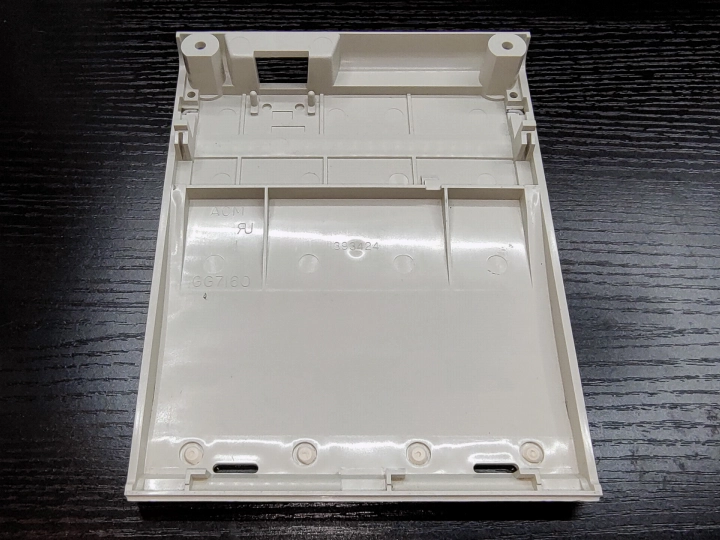
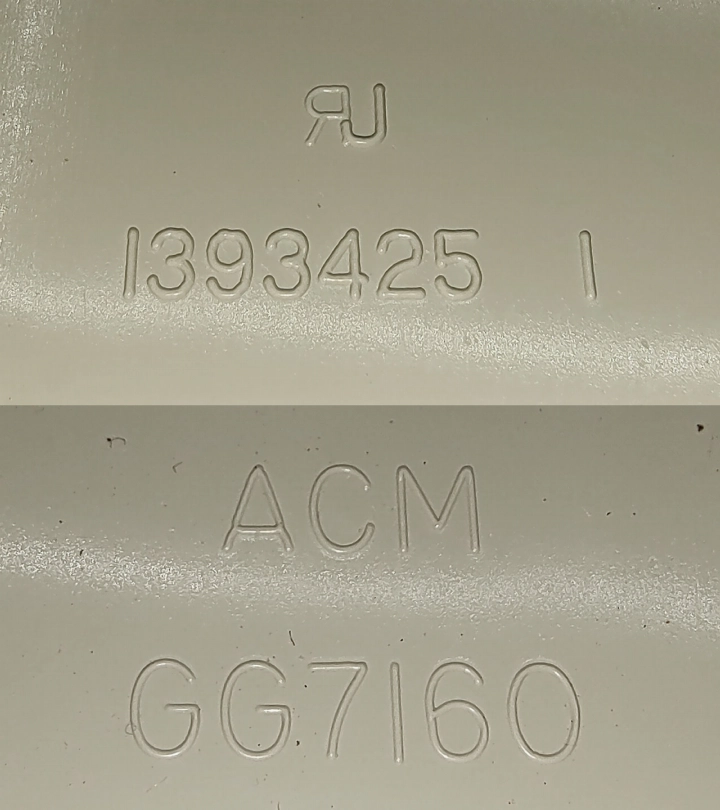
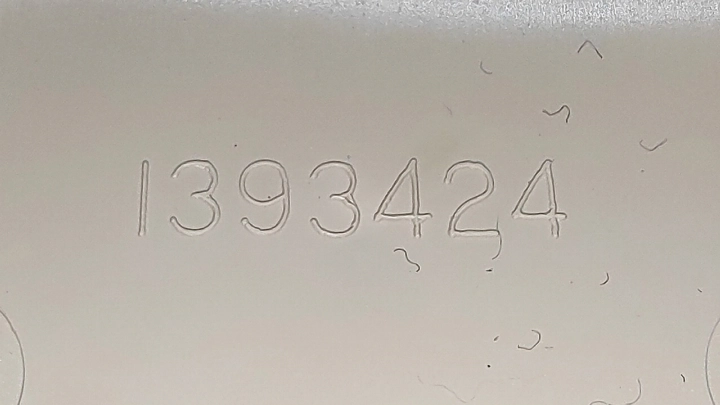
The cover material used is presently unknown. There are several markings on the inside of both the top and bottom cover pieces including "ACM" and "GG7160" that may be significant in regard to the material used. The top cover piece part number is 1393425 and the bottom piece part number is 1393424.
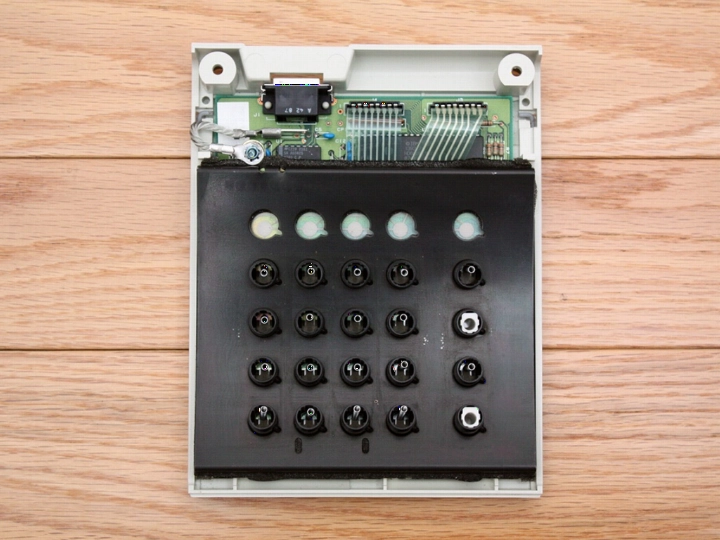
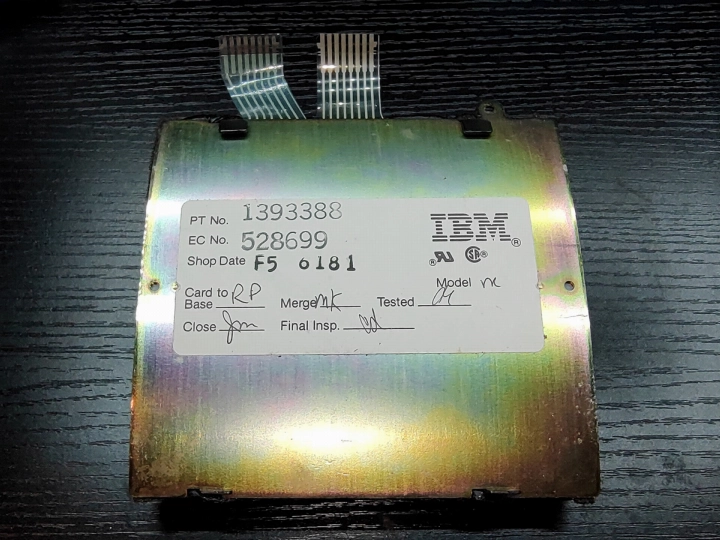
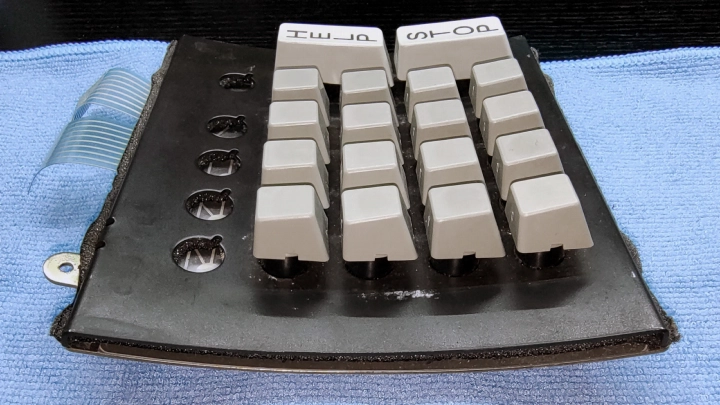
Inside the keypad is a curved sub-assembly (P/N 1393388) made up of four distinct layers; the keyboard frame, the foam layer, the membrane assembly, and the base plate. This design can be described as a hybrid of Model F and (buckling spring) Model M principles. Whilst it's indeed still a membrane-based keyboard, the keyboard frame and use of foam are Model F characteristics. This is because the assembly design is derived from the IBM 3290-1/5080 Numeric and Program Function Keypads first released in 1983 - in fact, there are disused key positions visible that would have been used by this predecessor keypad. The only other Model M-designated keyboard that is similarly designed is the IBM PS/2 50-key Function Keyboard.
- The keyboard frame (aka, "barrel plate") sits top facing and is used to guide individual switch components (the buckling spring actuators) to their correct position above the membrane assembly's contact points. The Screen Reader Keypad's frame is metal and the individual cylindrical frames ("barrels") are separate components, much like a Model F keyboard design rather than a typical Model M one. It always has 25 'barrel' cut-outs from its IBM 3290-1/5080 keypad origins, but only 20 are normally used (18 active switch positions and two stabiliser inserts).
- The foam layer that sits below the keyboard frame and likewise has cut-outs for individual keyswitch barrels. It is used to secure these barrels in place and act as a general gasket for the host frame. The thickness of the foam is said to be about 2mm to 3mm[18].
- The membrane assembly (layer P/Ns 1393414 and 1393417) is a part of the keyswitch system used as the circuitry to be actuated and facilitates a 8x7 matrix. This is another difference to a Model F keyboard design, which a pad card instead.
- The base plate (aka, "back plate") provides rigidity and the curvature for all the other layers to follow.
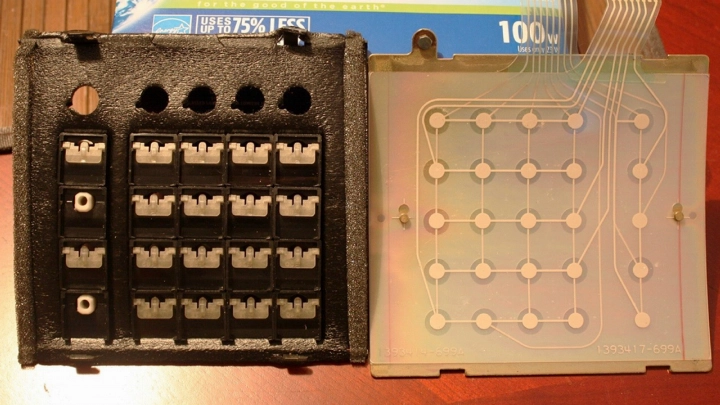
The keypad assembly sits in the cover set's bottom piece. The assembly's bottom lip is caught by 3 plastic hooks near the bottom. Unlike typical Model M keyboard assemblies, no plastic rivets are used in this design. Instead, the assembly has two sliding hooks at the bottom and two tabs at the top to hold everything together and thus there will never be a need to bolt/screw mod it. For some Model Fs, the foam can invariably degrade and become a possible cause for concern. Foam degradation typically doesn't result in a major technical fault, but a typical side effect is that keys are more prone to rotating in their place. Whilst a Screen Reader Keypad with such a catastrophic foam loss has yet to be observed, replacing the foam layer in a Model F (and by extension, this keypad) is a documented procedure on deskthority.
This design also lacks a membrane blanket, a rubber or latex sheet used in other Model M designs to dampen the stress the actuators exert on the membrane assembly. An Unicomp employee posting on the IBM Keyboards Discord server has stated that a Model M without the blanket is unlikely to reach the usual rated 25 million key-presses lifetime[20], but as this keypad isn't designed for regular typing or numeric entry, it's possible IBM believed a membrane blanket wasn't necessary for this application.
The Screen Reader Keypad's keycaps are IBM's famed PBT dye-sublimated keycaps. Versus the most common keycap material, ABS[21], PBT is more durable, does not degrade/yellow with age, UV or heat exposure, and will keep its texture for longer without shining[22]. Dye-sublimation is also a very durable text printing method that sinks dye material into the keycap's plastic itself, meaning there is nothing to quickly wear off as would be the case with pad-printing or silk screening. This means these keycaps can remain in good condition for a long time. The dye sublimation quality will be similar to contemporary Model Ms but unique to Screen Reader Keypad is their larger font.
Rear labels
More information: Keyboard Rear Labels
Like most Model Ms, the Screen Reader Keypad employs a recognisable rear label (casually referred to as a "birth certificate") both on the back of the cover set and the back of the internal assembly that can be used for identification via a part number and model designation and for dating the device.
External rear label
The rear label on the back of the Screen Reader Keypad is a modification of a standard IBM United States-style rear label. The formatting of the standard data (part number, ID/serial, etc.) remains the same, although an FCC ID surrounded in a black box and an FCC compliance statement underneath it are included. Whilst Lexmark and Unicomp era keyboards could have such information included on the rear label, it's unusual for IBM-manufactured Model Ms to have such detail. The date format is typically DD-MMM-YY or MM-DD-YY.
Internal rear label
If present, the rear label on the back of the Screen Reader Keypad's internal assembly is an IBM United States staple without modification. As such, it has a four-digit internal shop date instead of a real date. Some Screen Reader Keypads lacked any internal rear label, instead having the assembly part number and a real date (MM-DD-YY format) stamped or written on the base plate instead.
The Screen Reader Keypad's controller card is essentially a small version of the original Enhanced Keyboard controller used during the 1980s. Its part number is 1393368 as per the copper filling on the back of the card. The card has a Hitachi HD6805 series microcontroller (specifically, HD6805V1N12P with IBM part number 1393371). The HD6805V1 series is a 1MHz NMOS 8-bit MCU with 96B RAM, 3.838KB ROM, 24 I/O ports, and 8 input-only ports[25]. The membrane assembly connects to the card via two 8-pin 2.54mm pitched Triomate connectors (although one pin on the second connector is not used by the membrane's matrix). The card has a large ground wire that is screwed onto the keypad's assembly's base plate.
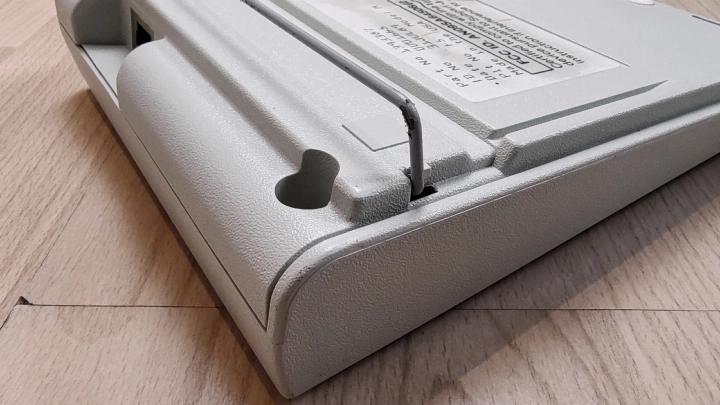
The Screen Reader Keypad has a single flip-out foot unlike anything used on other Model M keyboards. It's a metal bar that heavily resembles the stabiliser element used on buckling spring Model M spacebars. It appears to have a grey-coloured coating that can wear or flake off.
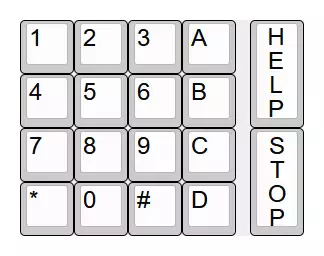
The Screen Reader Keypad is not designed as a replacement or alternative to a computer's numeric keypad, hence even the 3x3 number section is different to a typical numpad. The number keys plus the "*", "0" and "#" keys are instead arranged like a United States telephone keypad. Both the "5" and "A" keys have homing bumps for orientation. The "HELP" key was used as a toggle to enter a Help mode in the Screen Reader software. Whilst in this mode, the software would tell you what each key does when you press it. The "STOP" key functioned like a general cancel button within the Screen Reader software and was able to interrupt text-to-speech[26].
Connectivity
The Screen Reader Keypad is technically a PS/2 compatible device but there are some important considerations. Whilst the form of physical connectivity matched that of most early PS/2 compatible Enhanced Keyboards, the Screen Reader Keypad was actually designed to connect through either a PS/2 compatible PC's mouse port or via an ISA card for early IBM PC compatibles (seen below). As such, this keypad will not provide any meaningful operation through a modern PC's PS/2 keyboard port, an active PS/2 to USB converter or via any PS/2 mouse port without the required software. Until a modern converter has been devised, one would either need to use the keypad for its intended purpose on legacy hardware or replace the controller card with something purpose designed.
The Screen Reader Keypad features a 6-pin modular AMP shielded data link (SDL) port and a detachable cable, a known staple for PC-compatible Model Ms from the 1980s and early 1990s. This allows the keypad to be uncoupled from its cable as needed for storage or easy swapping. The cable was typically a high-quality grey and thick coiled cable, and for the Screen Reader Keypad specifically had a part number of 72X8537. The cable ends with a PS/2 port with a standard pinout, however as aforementioned, the keypad's hardware itself will not support it being used with a PS/2 keyboard port. However, the cable can be used for other SDL-bearing Model Ms and likewise other SDL to PS/2 cables can be used as a substitute for the Screen Reader Keypad's original cable.
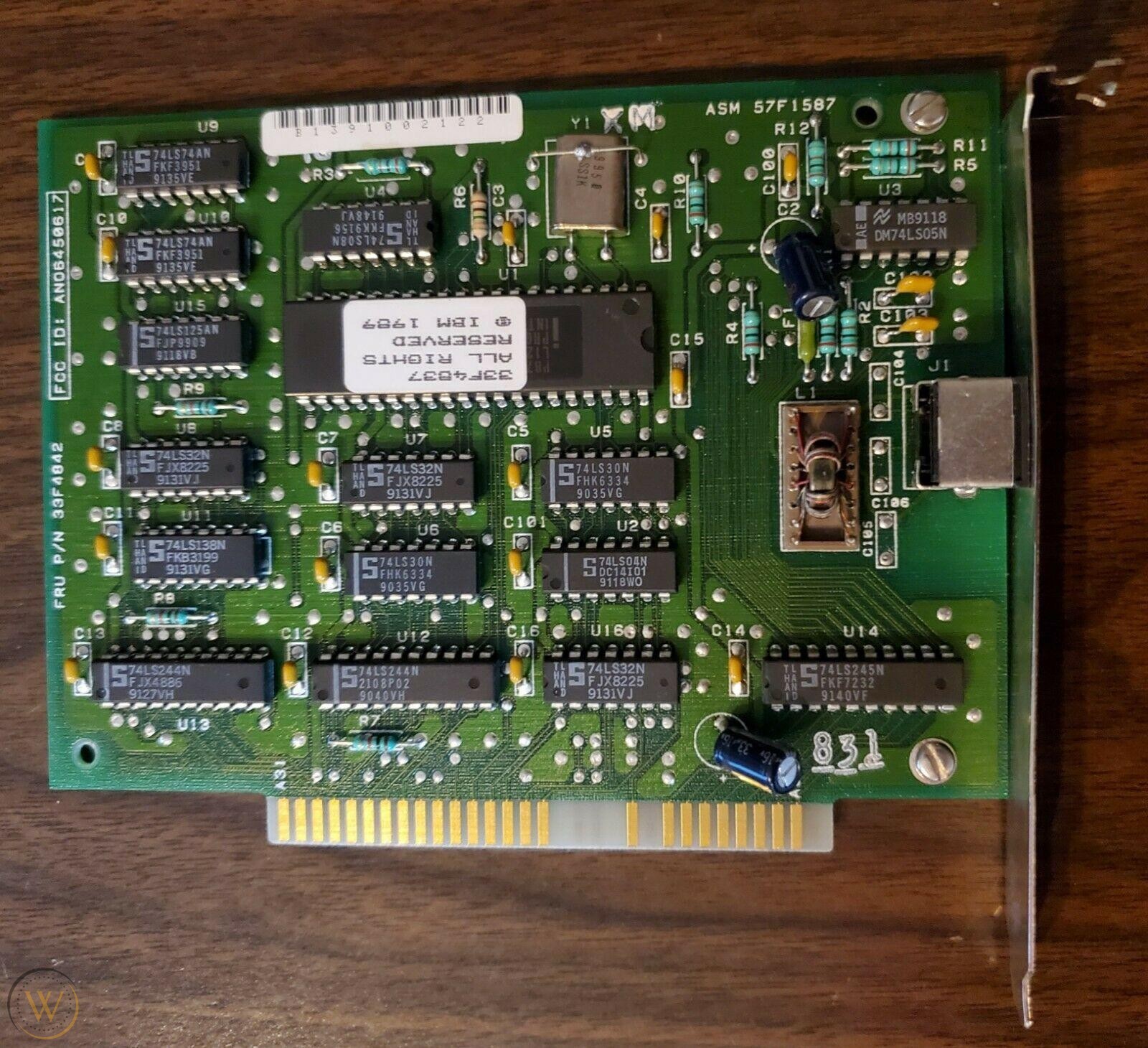
For PCs lacking a PS/2 port such as IBM PC/XT and PC/AT compatibles, IBM made an 8-bit ISA expansion card available that provided a PS/2 port to connect the Screen Reader Keypad with. This card was called the IBM Screen Reader Adapter; P/N 57F1588, assembly P/N 57F1587, FRU 33F4842.
Internal
External
- IBM - The IBM PC's debut details - The first 10 years [accessed 2022-11-10]. License/note: retrieved via Wayback Machine (2022-11-10 capture).
- IBM - IBM Screen Reader/2 Brief Description of Announcement, Charges, and Availability (#292-363) [accessed 2023-03-07].
- IBM - Withdrawal: IBM Screen Reader Keypad and Cable -- Replacement Available (#195-112) [accessed 2023-03-08].
- American Foundation for the Blind - A History of Accessibility at IBM [accessed 2023-03-06].
- FCCID.io - International Business Machines Corporation 9SA6450602 [accessed 2023-03-06].
- IBM - IBM Customer Announcement Summary - January 26, 1988 (#C88-001) [accessed 2023-03-08].
- IBM - PS/2 Screen Reader Version 1.0 Withdrawal from Marketing (#289-579) [accessed 2023-03-08].
- IBM - Screen Reader Version 1.1 Brief Description of Announcement, Charges, and Availability (#289-578) [accessed 2023-03-08].
- IBM - IBM Screen Reader/DOS Version 1.2 Brief Description of Announcement, Charges, and Availability (#292-364) [accessed 2023-03-08].
- IBM - IBM Screen Reader Features Brief Description of Announcement, Charges, and Availability (#192-154) [accessed 2023-03-08].
- IBM - IBM Screen Reader/2 Version 1.21 Announcement Letter (#ZP93-0544) [accessed 2023-03-08].
- IBM - Withdrawal from Marketing - IBM Screen Reader/2 Version 1.2.1 (#A95-1465) [accessed 2023-03-08].
- IBM - IBM Screen Reader/2 Version 2.0 Announcement Letter (#A95-1198) [accessed 2023-03-08].
- snuci - File:IBM Screen Reader Pad membrane exposed through absent keys.jpg [accessed 2023-03-09]. License/note: public domain.
- Shaddim - File:Bucklingspring-animation-300ms.gif [accessed 2021-09-09]. License/note: CC-BY-2.0.
- IBM - Rocking switch actuator for a low force membrane contact switch [accessed 2021-06-17].
- Unicomp - The Customizer Keyboard [accessed 2022-10-04]. License/note: retrieved via Wayback Machine (2000-06-14 capture).
- deskthority - Replacement foam in IBM Model F [accessed 2022-07-01].
- snuci - File:IBM Screen Reader Pad odd mix of Model F plates and Model M paddles and membrane.jpg [accessed 2023-03-09]. License/note: public domain.
- troyfletcher#5223 - Discord Message #252446027745853442 on IBM keyboards | /r/ModelM & F [accessed 2023-02-21].
- WASD Keyboards - Mechanical Keyboard Guide [accessed 2022-07-01].
- Switch And Click - ABS vs PBT Keycaps: What’s the Difference? [accessed 2021-09-09].
- snuci - File:IBM Screen Reader Pad back.jpg [accessed 2023-03-08]. License/note: public domain.
- Parak - Re: IBM screenreader (buckling spring numberpad)#msg894270 [accessed 2023-03-08]. License/note: permission requested and explicitly given via direct messaging.
- Hitachi - 8-Bit Single-Chip Microcomputer Data Book (#U71) [accessed 2023-03-12]. License/note: document archived by bitsavers.
- IBM - IBM Independence Series Screen Reader/2 Getting Started [accessed 2023-03-12].
- WorthPoint - IBM Screen Reader/2, Brand New, with ISA Interface Card & 4 Keypad Cables [accessed 2023-03-12]. License/note: used under fair dealing.
| Published | Comment |
|---|---|
| 22nd May 2025 | Updated summary table design |
| 1st October 2024 | Replaced various used enthusiast terminology with official terminology, rewrote "Internal assembly" & updated inflation adjustments to 2023 in "Prices" |
| 18th November 2023 | Moved introduction ahead of Contents & updated Unicomp New Model M link |
| 1st August 2023 | Update references to the 24/25-key Model F keypad to reflect recent changes made to the IBM Model F keyboards wiki page |
